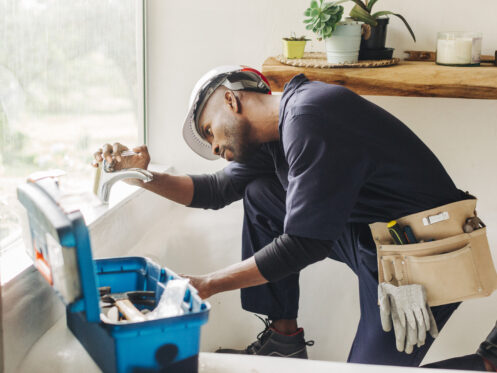A little spring plumbing maintenance can help you avoid leaks, backups, or worse. With just a little care, you can make sure your plumbing is in top shape, giving you one less thing to worry about as the weather warms up.
Checking for Leaks After a Long Winter
Winter can be rough on your plumbing even if everything seemed fine while the temperatures were freezing. Pipes, faucets, and hoses don’t always show damage right away. Sometimes, it’s when the warmer days hit and you start using everything again that the trouble begins. A small crack in a pipe that froze over the winter might stay hidden until you turn on the water, and suddenly, you’re mopping up a puddle under your sink.
Start by taking a slow walk around your house, inside and out, with your eyes and ears open. Turn on each faucet and let it run for a minute. Look underneath the sink and along the walls for any drips. Don’t forget the basement if you have one. Pipes down there can, sometimes. be the first to freeze in the winter, and if there’s any moisture or a musty smell now, it could mean water is getting where it shouldn’t. You might not see a big gush, but water stains on the ceiling can be a sign that something started leaking months ago. Catching it now could save you from having to tear out the drywall later.
Testing Your Outdoor Faucets and Hoses
Once spring rolls around, you probably can’t wait to get outside. Before you get too far, though, those outdoor faucets deserve a quick check. Winter can be especially tough on the spigots outside your house, and you don’t want to find out they’re busted when water starts spraying everywhere.
Turn on your outdoor faucet slowly the first time, and watch what happens. If you hear a loud rushing noise but don’t see water coming out, that’s a sign something might be broken inside the wall. That kind of hidden leak can cause water damage behind your siding or in your basement, and it’s better to spot it early.
While you’re at it, check your hose. If it sat out all winter, it could have cracked. Even if it was stored away, old rubber hoses can wear out over time. Give it a good look before hooking it up.
Clearing Slow Drains Before They Get Worse
You know that drain that’s been a little slow all winter? The one you keep meaning to fix but haven’t gotten around to? Spring is a good time to tackle it. What starts as a slow drain can become a full-on clog quickly.
Hair, soap scum, and grease are often the culprits, especially in bathroom and kitchen drains. Over time, they build up along the walls of your pipes, narrowing the path water can take. You might notice the sink draining a little slower or hear a gurgling sound when the water goes down. That’s your warning sign to act before it becomes a bigger problem.
A simple drain cleaner can help, but sometimes, a plunger or a drain snake works better, especially for tough clogs. If you’ve got a stubborn drain that’s been acting up for months, it might be time to have it checked to make sure there isn’t a bigger issue further down the line.
Checking Your Sump Pump Before Spring Rains Hit
Spring showers can be a nice break after a long winter, but all that rain can cause problems if your sump pump isn’t working right. If your home has a basement, that little pump is what keeps water from flooding in when the ground gets saturated. It’s one of those things you don’t think about until it stops working, right when you need it most.
Before the heavy rains start, pour a bucket of water into the pit where your sump pump is located. The pump should kick on and start pumping water out almost immediately. If it doesn’t or makes strange noises, there might be an issue. Sometimes, the pump gets clogged with debris, or the float switch that triggers it can get stuck.
Also, check where the water is being pumped out. It should be draining away from your house, not pooling up near your foundation. Water that’s not properly redirected can seep into your basement, causing damage and mildew. Making sure your sump pump is ready can save you from scrambling to find towels and buckets during the next big storm.
Inspecting Pipes for Signs of Corrosion or Wear
Pipes can last a long time, but they don’t last forever. Spring is a great time to give your visible pipes a once-over, especially in older homes. Sometimes, wear and tear sneak up slowly, and what looks like a little rust or discoloration can actually be a sign that your pipes are weakening.
Look at the pipes under your sinks, in the basement, or anywhere else they’re exposed. If you see green stains on copper pipes, that could mean there’s a slow leak or moisture collecting. Rust on steel pipes is another warning sign. Over time, corrosion can eat away at the pipe, leading to leaks or a burst.
Pay attention to any pipes that look like they’ve been wrapped with tape or sealant before. That could mean someone tried to patch a leak in the past. Those quick fixes don’t always hold up forever, and it might be time to replace the section before it fails again.
Checking Toilets and Faucets for Small Leaks
A running toilet might not look like much of a problem, but it can waste a lot of water every day. That can make your water bill climb higher and put more wear on your plumbing over time. Sometimes, the problem is as simple as a worn-out flapper inside the tank. You can usually hear a constant trickling or the sound of water refilling when no one’s used the toilet.
Faucets can drip for months before you really notice, especially if it’s in a guest bathroom you don’t use often. Even small drips add up. A slow leak can waste thousands of gallons of water over time, and if it’s under a sink, it can damage your cabinets or the floor.
Feel around the base of your faucets and under the sink. If anything feels damp or you notice a musty smell, there might be a small leak. Fixing it now is easier than waiting until it becomes a bigger issue. Sometimes, all it takes is tightening a nut or replacing a washer, but catching it early can prevent water damage later.
Call Us Today
Spring should be about enjoying the sunshine, not dealing with surprise plumbing issues. Taking some time now to check your pipes, faucets, and drains can save you from bigger headaches later. At Hope Plumbing, Heating and Cooling in Indianapolis, IN, we’ve helped plenty of homeowners get their plumbing systems ready for spring. Schedule your spring plumbing checkup with Hope Plumbing, Heating and Cooling today.


